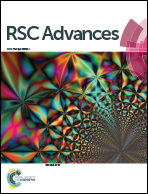Ultrathin anatase nanosheets with high energy facets exposed and related photocatalytic performances†
Abstract
Anatase-type titania with ultrathin nanosheet morphology and sintering-resistant structure was constructed from monolayer titanate nanosheets isolated by uniform silica nanoparticles. The obtained anatase titania nanosheets possess high accessible surface area, ultrathin thickness (∼0.6 nm), dominant (116) facets exposed, wide bandgap and exhibits excellent photocatalytic activity.



 Please wait while we load your content...
Please wait while we load your content...